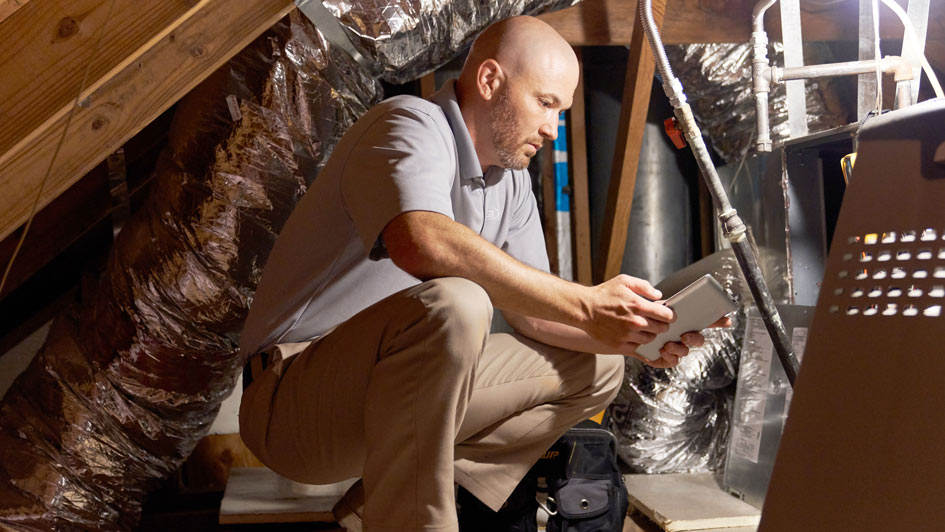
Where you aware that more than 50% of your home’s energy costs are from your heating and cooling? This is why it’s so important to secure an energy-efficient HVAC system.
Furnace efficiency standards were last revised to an Annual Fuel Utilization Efficiency (AFUE) rating of 80% in 2015. This rating system calculates how effective your furnace is at converting natural gas into heat. An AFUE rating of 80% means your furnace loses about 20% of the fuel it uses while producing heat.
In 2022, the Biden Administration devised new energy-efficiency standards for residential gas furnaces that would significantly decrease emissions, save customers money and promote sustainability.
These revised standards are projected to:
- Save Americans $1.9 billion annually.
- Reduce carbon emissions by 373 million metric tons and methane emissions by 5.1 million tons over three decades, the equivalent of what 61 million homes emit each year.
Starting in 2029, the updated rule would require all new gas furnaces to feature AFUE ratings of 95%. This means furnaces would turn nearly 100% of the gas into usable heat.
So what does all of this mean for your existing furnace in 2023? As of now, not much, as the proposed rule won't go into effect until 2029 at the earliest and doesn’t affect furnaces that are already in use.
But if you need furnace replacement in soon, highly energy-efficient furnaces are now available. Find out how these furnaces can save you money on your utility bills.
Guide to Condensing Furnaces
How Condensing Furnaces Work
A condensing furnace is a type of heating system that uses a secondary heat exchanger to trap wasted heat from the furnace's exhaust gases. This decreases the quantity of energy wasted, increases energy efficiency and lowers carbon-monoxide emissions. It also requires less natural gas to generate the same volume of heat when comparing one to other types of furnaces.
How Condensing Furnaces Differ from Non-Condensing Furnaces
The primary difference between a condensing furnace and a non-condensing furnace is condensing models use a secondary heat exchanger to collect any wasted heat from its exhaust gases, while the latter does not.
Expected Longevity of a Condensing Furnace
The life span of a condensing furnace will depend on the brand, model and other factors. In most cases, a condensing furnace is likely to last between 10-20 years with appropriate maintenance and regular service. If you put off scheduled maintenance, it may struggle to perform as well, ultimately failing earlier than anticipated.
Why Condensing Furnaces Cost More
For the most part, condensing furnaces are more cost most to install than non-condensing furnaces. This is due to their increased efficiency and the extra features required to capture any wasted heat from its exhaust gases. However, the additional energy savings can often recoup the price of purchase. So over time, it may be more cost efficient to consider investing in a condensing furnace.
Guide to Variable-Speed Furnaces
Variable-Speed Furnaces: What You Need to Know
A variable-speed furnace can vary its fan speed to minimize the energy necessary to satisfy the heating needs of your home. It starts at a slower speed until it detects a drop in temperature and then ramps up to generate more heat. This [precise fan is significantly more efficient than conventional furnaces, as it only utilizes the minimum amount of energy required to heat your home, saving you money in the long run.
Many variable-speed furnaces are condensing furnaces, although a few are available in non-condensing models with lower AFUE ratings. If a manufacturer wants a furnace to be classified as a condensing furnace, it must offer an AFUE rating of 90% or higher.
Do Variable-Speed Furnaces Run All the Time?
A variable-speed furnace doesn’t run all the time. Rather, it runs at different speeds based on the temperature in your Pocatello home as well as the amount of energy it needs to reach that temperature.
When sufficient energy is demanded to maintain your desired temperature level, the furnace will switch to a higher speed in order to keep up with demand. Precise fan speeds offer more efficient heating in your home while also providing quieter operation.
Guide to Two-Stage Furnaces
Two-Stage Furnaces: What They Are and How They Work
A heating system with two settings of operating - high and low - is called a two-stage furnace. On the low stage, the furnace runs at a reduced capacity in order to maintain the chosen temperature in your home more efficiently. During the high stage, the furnace will instead run at maximum capacity to satisfy demands for more heat. With a two-stage furnace, you can enjoy enhanced energy efficiency and comfortable temperatures everywhere in your home.
While two-stage furnaces are extremely efficient, not all all models are condensing furnaces.
Does a Two-Stage Furnace Operate All the Time?
A two-stage furnace does not stay on indefinitely. In the low stage of operation, the furnace runs at reduced capacity in order to maintain a desired temperature more efficiently within your home. When a greater demand for energy is needed to reach the set temperature, the furnace switches to its high stage and operates at full capacity. As such, two-stage furnaces are able to help reduce energy costs without operating continuously.
Differences Between Two-Stage and Variable-Speed Furnaces
Two-stage furnaces have two stages of functionality, low and high. During the low stage, the furnace performs at reduced capacity to help maintain a desired level of comfort within your home. When a greater demand for warmth or cooling is needed, the furnace will switch to its high stage and operate at full capacity.
Variable-speed furnaces, meanwhile, can run at several speeds in order to uphold a more precise temperature at home. With more options for temperature settings, you also have more flexibility for heating you home and can enjoy greater savings on energy bills.
Differences Between One- and Two-Stage Furnaces
One-stage furnaces have a single stage fan speed and operate either at full capacity or not at all. In other words, the furnace runs constantly in order to maintain a desired temperature within your home.
Two-stage furnaces, by comparison, have two stages of operation, low and high. While in the low stage, the furnace runs at reduced capacity in order to maintain the desired temperature more efficiently. When additional warmth or cooling is needed, the furnace will change over to its high stage and operate at full capacity.
Make Your Furnace Installation Appointment with Vogts Heating & Air Today
It takes experience and dedication to stay up to date about furnace technology advancements. That’s why Vogts Heating & Air specialists are here to help with a free, no-pressure estimate for furnace installation. We’ll assess your home, your heating needs and your budget before helping you find the ideal solution. Contact us at 208-621-0129 to get started today!
